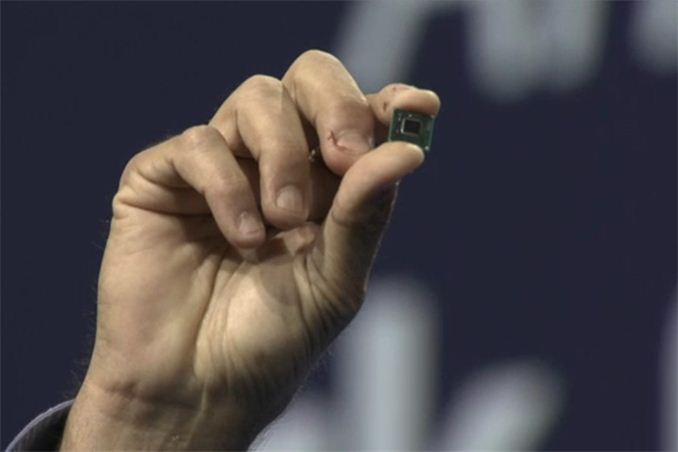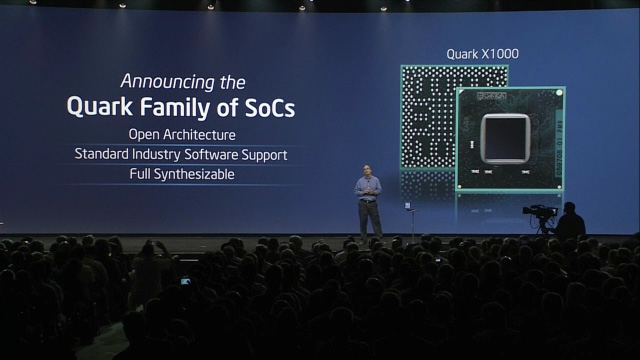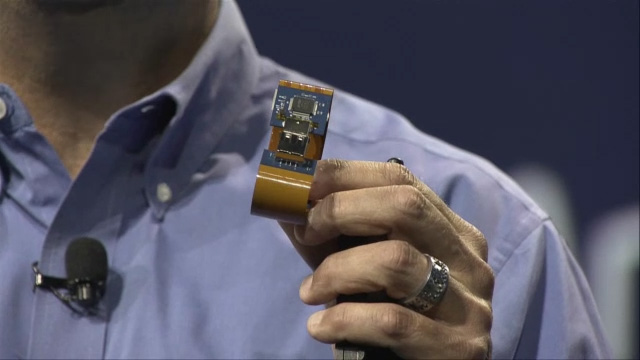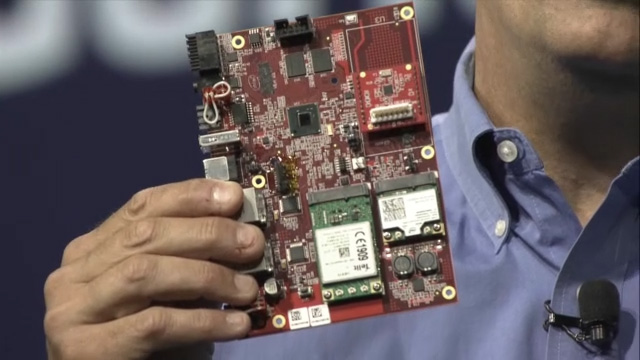Intel Announces “Quark” SoC Family: Tiny SoCs For Tiny Devices
by Ryan Smith on September 10, 2013 2:05 PM EST
Kicking off today is the 2013 Intel Developer Forum, Intel’s annual gathering of developers, press, and techies. Among the many sessions scheduled over the rest of the week we’re expecting several product announcements, and as is customary the first few of these announcements have been dropped in this morning’s opening keynote, being delivered by Intel’s new CEO, Brian Krzanich.
The first – and certainly hottest item – is the announcement of a new line of SoCs from Intel. Dubbed the Quark family, these SoCs will be slotted in below Intel’s existing and future Atom products, being designed with a strong emphasis on size and power consumption. Intel isn’t giving the press any hard numbers at this time, but they are throwing around the idea of one-fifth the size and one-tenth the size of their existing low-end Atom (Silvermont) CPU cores. Based on these statements a quick extrapolation in turn suggests that the die size of Quark is going to be under 10mm2 and targeting power consumption under 100mW, reinforcing just how small and low power Intel is going with these chips.
Update: Intel has sent over a quick clarification on size; the size comparisons are meant to be core-to-core rather than SoC-to-SoC. Specifically compared to the 22nm Silvermont core.

Being smaller, lower power, and less powerful than Atom, Intel will be chasing after the “internet of things” market with Quark products. With Atom covering tablets, smartphones, and similar devices, Intel is tasking Quark with covering the markets that traditionally use embedded microprocessors and other types of low power, low performance controllers. This would cover everything from wearable computers to smart watches on the consumer side, and any number of uses in industrial products as we already see today. Intel for their part isn’t going to be going into producing any such end user devices, but they are showing off some braclet-like devices as proof of concept reference designs at the show.
Looking at the specs and the use cases, although Intel doesn’t specifically name ARM as a competitor here, it’s clear that Intel is going after ARM’s other market segments to at least some extent with Quark. ARM’s Cortex M and Cortex R processor IP already competes in the spaces that Intel is naming for Quark, so there is some obvious overlap there. Furthermore ARM juggernaut Qualcomm has shown a clear interest in the “internet of things” concept and its potential to be the next explosive market, and have in turn been working on their own Cortex M based designs and sample products using them, such as the recently announced Toq smartwatch.

But perhaps the most interesting aspect of Quark is what hasn’t been said: architecture. Intel has not specifically named the architecture that Quark will be based on, which calls into question whether it will be based on x86 – like virtually all of Intel’s other microprocessors – or if they’re utilizing another architecture to meet the extreme size and power requirements of Quark. At the same time Intel is calling Quark an “open architecture” product, which is not a term they typically attach to x86. Hopefully we’ll be able to get Intel to talk more about the architecture once we hit the showfloor.
Update: Intel has confirmed to us that Quark's architecture is "Pentium ISA compatible", making it x86 for the purposes of the front-end.
Wrapping things up, alongside the announcement of Quark Intel has also briefly laid out their launch plans for the new SoC. As to be expected, Quark isn’t shipping yet. The first Quark product will be 32nm, with Intel sampling reference boards based on that SoC in the 4th quarter, followed by a full release occurring at a yet-to-be-announced point after that. For the initial wave of Quark products Intel will be playing it conservatively, targeting existing industrial microcontroller users such as energy, transportation, and other general industrial segments. These are the markets where Quark is closest to a drop-in replacement, while Intel’s more ambitious vision for consumer markets will take further time to develop as their partners continue to work out product designs and where such an SoC makes sense.

Source: Intel










26 Comments
View All Comments
jwcalla - Wednesday, September 11, 2013 - link
Apparently it means you can piece together your SoC, kind of like you can on ARM.But yeah, when I think "open architecture" I think of something like SPARC.
Arnulf - Wednesday, September 11, 2013 - link
What kind of performance and power consumption while running at 100% and when idling are we really looking at ? "Compared to Silvermont" doesn't mean much because Silvermont extends an order of magnitude across the planned line-up. I want to know how far technology has progressed since the days of 10-15W Pentiums :-)I used one Pentium system (150 MHz) for better part of a decade (before its PSU gave up) as firewall/router/NAS and it performed admirably. If Intel can offer this kind of performance on a board the size of a credit card (with SoC the size of a fingernail being the center of it and various connectors and PSU components taking up most of the board's real estate) at negligible power consumption, they will drive MIPS et al out of networking world entirely.
MrSpadge - Wednesday, September 11, 2013 - link
This level of performance should be relatively easy to reach for them, I guess.MrSpadge - Wednesday, September 11, 2013 - link
Things could get interesting if Intel also went for BIG.little configurations with Quark and Atom, or Quark + Atom + high end. It would not even have to be completely symmetric, like Samsung currently still does it. Maybe just 1 tiny core for some power saving, or many tiny cores for micro servers, with a few big cores for time-critical tasks.arms8586 - Friday, September 13, 2013 - link
A very insightful article on how Intel is finding new avenues to attack ARM while still sticking to x86. However, I have some reservations on its success since, power becomes biggest concern as size decreases and devices run on battery. Anyway, more detail by Q4 would give deeper insights on relation between power, performance and cost and thus a fair comparison with ARM.Btw, there is a typo. It says "but they are throwing around the idea of one-fifth the size and one-tenth the size of their existing low-end Atom (Silvermont) CPU cores". It should be one tenth of power instead of size. Here is the transcript. http://goo.gl/WvWmUF, page 10.
everex11 - Monday, September 16, 2013 - link
as Dorothy explained I can't believe that any one able to make $5224in one month on the computer. look at this web-site......www.pick85.com/